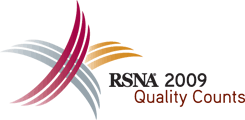
Abstract Archives of the RSNA, 2009
SSM11-04
Radiofrequency Ablation of Renal Tumors: Diagnostic Accuracy of Contrast-enhanced Ultrasound for Early Detection of Residual Tumor
Scientific Papers
Presented on December 2, 2009
Presented as part of SSM11: Genitourinary (Ablation and Intervention)
Christine Caroline Hoeffel MD, Presenter: Nothing to Disclose
Maud Pousset, Abstract Co-Author: Nothing to Disclose
Olivier Helenon, Abstract Co-Author: Nothing to Disclose
Samuel Merran MD, Abstract Co-Author: Nothing to Disclose
Francois Tranquart MD, Abstract Co-Author: Research Consultant, Bracco Group
Research Consultant, Theraclion
Jean-Michel Correas MD, Abstract Co-Author: Advisory Board, Koninklijke Philips Electronics NV
Speaker, Bracco Group
Consultant, bioMérieux SA
To evaluate diagnostic accuracy of contrast-enhanced ultrasound (CEUS) in early detection of residual tumor after radiofrequency ablation (RFA) of renal tumors.
After institutional review board apporval and informed consent were obtained for this prospective study, patients referring for RFA of renal tumors underwent CEUS and computed tomography (CT) or magnetic resonance imaging (MRI) before, within one day after treatment, and six weeks later. Identification of residual disease was assessed by three radiologists, for each imaging modality, blinded to other postprocedural imaging findings, and results were analyzed by consensus. Reference standard was CT/MRI performed at least one year after RFA. Inter-reader agreement was assessed.
66 renal tumors in 43 patients (median age 62 years; range 44-71.5) were studied. Inter-reader agreement (κ) was 0.84 for CEUS, inferior to that of CT/MRI (κ=0.94). Prevalence of residual disease was 19 % (14 out of 74 procedures). 24-h CEUS had a specificity of 98 % [CI, 91-100], and a sensitivity of 64 % [CI, 39-84]. The accuracy of CEUS was higher 6 weeks after the procedure, with a sensitivity of 79 % [CI, 52-92] and a specificity of 100 % [CI, 94-100]. Sensitivity and specificity for CT or MRI were of 79 % [CI, 52-92] and 95 % [CI, 86-98] respectively, at day one, and of 100 % [CI, 72-100], and 98 % [CI, 90-100], respectively, six weeks after. Predictive positive values for CEUS at day one and at 6-weeks were of 82 % [CI, 52-95] and 100 % [CI, 74-100], respectively, higher than those of CT/MRI (79 % [CI, 52-92] at day one and 91 % [CI, 62-98] at 6 weeks). Predictive negative values for CEUS at day one and at 6 weeks were of 92 % [CI, 83-97] and 95 % [CI, 87-100], respectively, almost similar to those of CT/MRI.
CEUS has high specificity and high predictive values for short-term detection of residual tumor after renal tumor RFA. CEUS appears as a reproducible technique. Its more limited sensitivity, particularly when performed within 24 hours after RFA, should be balanced against its benefits in terms of clinical tolerance and accessibility.
CEUS appears as a reproducible, non nephrotoxic examination with high predictive values and high specificity in residual tumor detection within 24 hours after radiofrequency ablation session.
Hoeffel, C,
Pousset, M,
Helenon, O,
Merran, S,
Tranquart, F,
Correas, J,
Radiofrequency Ablation of Renal Tumors: Diagnostic Accuracy of Contrast-enhanced Ultrasound for Early Detection of Residual Tumor. Radiological Society of North America 2009 Scientific Assembly and Annual Meeting, November 29 - December 4, 2009 ,Chicago IL.
http://archive.rsna.org/2009/8007372.html

